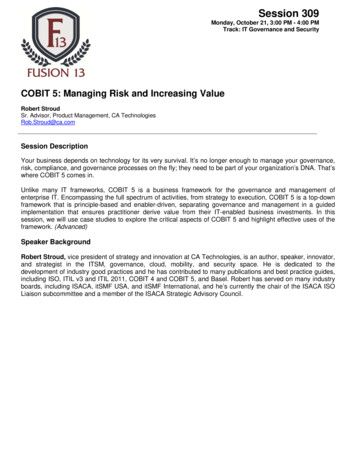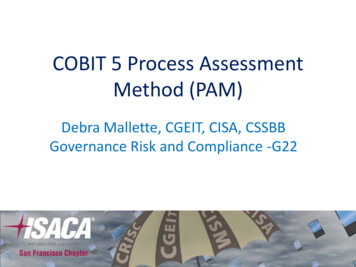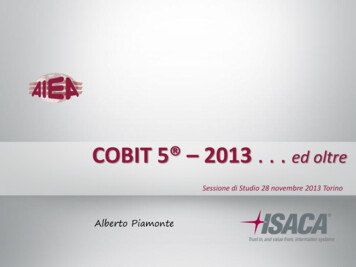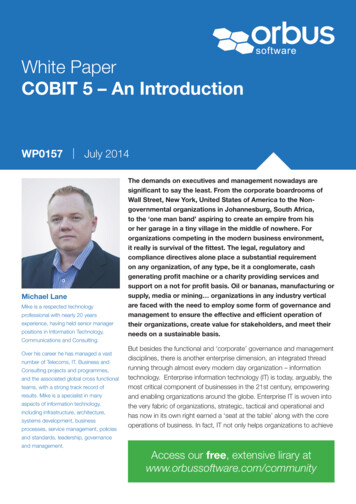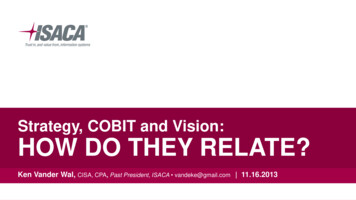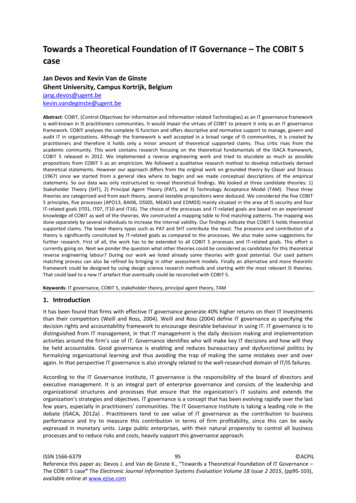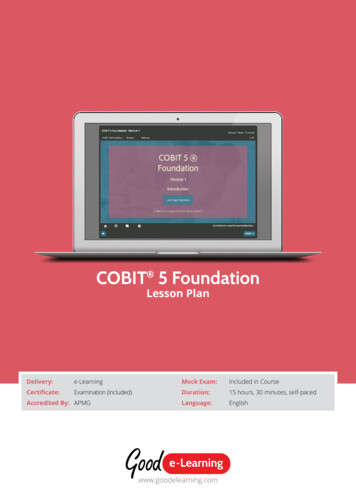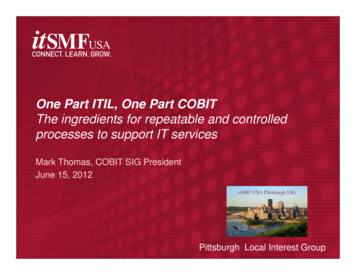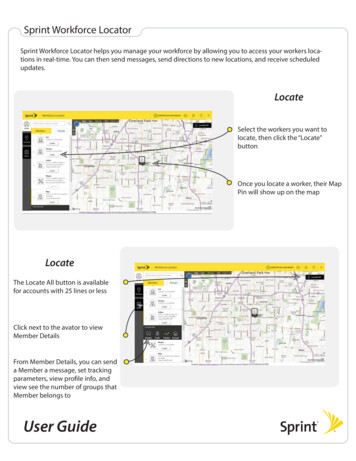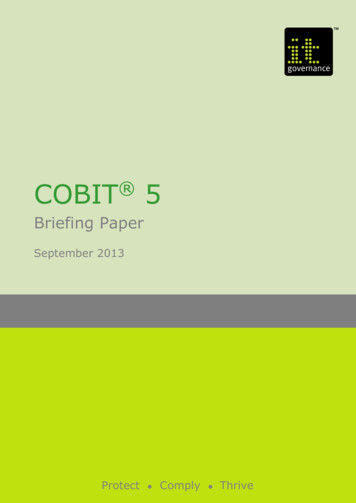Transcription
Fast Tracking COBIT 5for Information Securityand AuditingWhite paper written byKeyvan Shirnia: Head of Managed Services & Product ManagementChristina Kidd: Technology Evangelist
At Fusion Global Business Solutions, we helpcompanies gain measurable business outcomesfrom their investments in Digital Services andOperations Management.In this paper, we discuss how any organisationcan achieve higher levels of information securitymaturity by focusing on Asset and ConfigurationManagement. Our conversations and experienceswith our partners indicate that deploying logicaluse cases for Asset and ConfigurationManagement not only promotes informationsecurity holistically, but aligns you withcompliance standards and frameworks.Fast Tracking COBIT 5 for Information Security and Auditing2
Table of ContentsIntroduction2Information security: critical, yet challenging4The Importance of InfoSec5The Challenge with InfoSec5Case Study in Brief, Part 16Fusion Pro-Tip6Building Blocks for InfoSec Success: Asset Management & Configuration Management7Understanding COBIT 58Asset Management10Configuration Management11Case Study in Brief, Part 212Fusion Pro-Tip12Outcomes and Benefits: Managing and Maturing Data Quality13Assessing and Improving Data Quality14Case study in Brief, Part 315Fusion Pro-Tip15Outcomes and Benefits: Maturing Your Asset Management Process16The Future of Asset Management16Case Study in Brief, Part 417Fusion Pro-Tip17Next Steps18Fusion Pro-Tip18Resources19Fast Tracking COBIT 5 for Information Security and Auditing3
Information security: critical, yet challengingInformation security is a critical part of any business today.Without the right InfoSec protocols, you risk exposingyour company to data breaches that can wreak havoc onyour business and employees. It’s not hard to imagine:infrastructure failures, disclosure of confidential financialinformation, network intrusions, intelligence and personnelleaks, and even espionage. The most appropriate prescriptive framework toquantify and solve the gaps in your information security,by identifying and resolving capability gaps, improving thequality of asset data, and, most importantly, maturing theasset management governance and processes A “case study in brief”, describing our recent partnershipwith a global brand who needed speedy InfoSec solutions A set of Fusion Pro-Tips to enhance your InfoSec journey.Of course, non-secure information can also result inmajor incidents, downtime, failed industry audits,and non-compliance with mandated governance such asthe General Data Protection Regulation (GDPR) orPayment Card Industry Security Standards Council (PCI).At Fusion, we specialize in helping companies gainmeasurable business outcomes from their investments inIT Service Management and operations. Drawing on ourInfoSec experience, this whitepaper will provide:Fast Tracking COBIT 5 for Information Security and Auditing4
The Importance of InfoSecDigital transformation is effecting change in every part ofyour company. Two transformative areas stand out,for both their enormous potential and their enormouschallenges: the exponential potential of cloud services,including sophisticated architecture like serverlessapplications and microservices, and the proliferation ofconnected devices and the Internet of Things (IoT).These major developments are key drivers of complexity,and the more complex your systems, the more significantlyyour risk level increases.reducing your risk in increasingly complex environments.InfoSec is a requirement for successful digital transformation.Without proper InfoSec, you cannot connect services for azero-friction supply chain and you cannot move yourservices closer to your customers—both of which areagility requirements for successful businesses today.Delaying InfoSec improvements guarantees thatyour complexity, and hence risk, will becomeincreasingly challenging.Information security often feels like checking the boxes ofaudits and compliance. But those are only outcomes of goodinformation security. InfoSec is critical once it comes toThe Challenge with InfoSecInfoSec is comprehensive. It applies to every single partof your business. In an ideal world, everything your companyowns would be visible, allowing you to secure each pieceappropriately and continuously, minimizing risk byimproving control.the increased threat of attacks. Companies defer toIT frameworks as a path towards governance and riskmitigation, but a variety of IT enterprise and InfoSecframeworks offer ways to achieve information security.Which one is best? We’ll explore the most appropriateframework in the next section.However, as companies migrate data and workflowsto the hybrid cloud, the visibility and control requiredby information security become more challenging toaccomplish. IT must navigate various hardware, software,and third parties across the business supply chains in theattempt to protect and secure their information. Every assetmust be tracked for security and value optimization.Companies struggle to gain this visibility, even at themost elementary levels, because current tools, processes,and organisational structures are unable to cope withFast Tracking COBIT 5 for Information Security and Auditing5
Case Study in BriefPart 1Last year, a global retailer contacted Fusion for help with its informationsecurity. The company operates 400 stores worldwide and has revenues inexcess of 4 billion USD per year. Despite this success, the Chief InformationSecurity Officer, who reports to the Board of Directors, carried out an internalaudit that highlighted multiple challenges: A limited view of their assetsFUSION TIPS:Prioritize and narrow your focus.Avoid the mistake of managingevery single asset perfectly fromthe outset. Instead, start withyour top priority: your #1 problembecomes your use case. A siloed and incomplete set of asset management processes Limited ability to prevent, detect, and recover fromsecurity-related incidents Limited ability to report against the industry InfoSec standards,including PCI/DSS and GDPR, despite previous compliance Slow response time to InfoSec-related events.This was a common prospect for us: how to get the retailer to understandtheir assets and proactively manage the asset lifecycles. With this control,the retailer could then deploy a set of information security controls andgovernance that would minimize risk and achieve their primary objective offull compliance with GDPR and PCI. Without this control, the risk isenormous—and each day that passed without the delivery of a solution wouldsee the risk level increase. The company could inadvertently leak personal orproprietary data, resulting in reputation loss. They could unintentionally enableintrusions into financial networks. And in trying to remedy these situations,they could spend significant amounts on unplanned costs.More from our global retail partner case study in the next chapter!Fast Tracking COBIT 5 for Information Security and Auditing6
Building Blocks for InfoSec Success:Asset Management & Configuration ManagementAll security standards require assessing and understandingyour assets and configuration. These frameworks aim to helpcompanies answer two fundamental questions: What IT assets does your company use? What processes control these assets?With this understanding, frameworks can guide yourcompany towards a holistic IT asset management processthat can secure your information. In our experience,the long-standing framework COBIT 5, most commonlyused by auditors, provides the baseline for the vast majorityof security standards frameworks (such as the ISO/IEC27000 suite of information security management standards).Fast Tracking COBIT 5 for Information Security and Auditing7
Understanding COBIT 5Many companies already use the COBIT 5 framework forIT enterprise governance, either selectively or entirely.For companies with a mature IT configuration process,COBIT 5 can help define the requirements for a single sourceof truth for all IT assets. This is essential to InfoSec—andto the asset management processes governing the assetlifecycle, ownership, costs, and security controls.COBIT 5 spans 37 control objectives within five domains: Governance of Enterprise IT– Evaluate, Direct and Monitor (EDM) - 5 processes Management of Enterprise IT––––Align, Plan and Organise (APO) - 13 processesBuild, Acquire and Implement (BAI) - 10 processesDeliver, Service and Support (DSS) - 6 processesMonitor, Evaluate and Assess (MEA) - 3 processesProcess for Governance of Enterprise ITEvaluate, Directand MonitorAlign, Plan& OrganiseEDM01 EnsureGovernance FrameworkSetting and MaintenanceEDM02 EnsureBenefits DeliveryEDM04 EnsureResource OptimisationEDM05 EnsureStakeholder TransparencyAPO01 Manage the ITManagment FrameworkAPO02 ManageStrategyAPO03 ManageEnterprise ArchitectureAPO04 ManageInnovationAPO05 ManagePortfolioAPO06 ManageBudget and CostsAPO07 ManageHuman ResourcesAPO08 ManageRelationshipsAPO09 ManageService AgreementsAPO10 ManageSuppliersAPO11 ManageQualityAPO12 ManageRiskEDM03 EnsureRisk OptimisationAPO13 ManageSecurityBuild, Acquire& ImplementMonitor,Evaluate& AssessMEA01 Monitor, Evaluateand Assess Performanceand ConformanceMEA02 Monitor, Evaluateand Assess the Systemof Internal ControlBA101 ManageProgrammes & ProjectsBA102 ManageRequirements DefinitionBA103 ManageSolutions Identificationand BuildBA104 ManageAvailability and CapacityBA105 ManageOrganisational ChangeEnablementBA106 ManageChangesBA107 ManageChange Acceptanceand TransitioningBA108 ManageKnowledgeBA109 ManageAssetsDSS01 ManageOperationsDSS02 ManageService Requestsand IncidentsDSS03 ManageProblemsDSS04 ManageContinuityDSS05 ManageSecirity ServicesDSS06 ManageBusiness Process ControlsMEA03 Monitor, Evaluateand Assess ComplianceWith External RequirementsBA110 ManageConfigurationDeliver, Service& SupportProcess for Management of Enterprise ITFast Tracking COBIT 5 for Information Security and Auditing8
Asset and Configuration Management comprise the coreof COBIT 5. Therefore, we’ll focus on its Build, Acquire andImplement (BAI) domain. BAI establishes how to identify,acquire and implement IT requirements and technologywithin your company’s current business processes.Importantly, Manage Assets (control process BAI09) andManage Configuration (BAI10) provide underlying ITasset information, that is then either directly or indirectlyconsumed by all other COBIT 5 processes.This diagram visualizes the central roles of AssetManagement and Configuration Management in COBIT 5.The closer a process is to this core, the more that process willrely on Asset and Configuration Management.IT Management & Governance FrameworkSTRATEGY &GOVERNANCEEDM01APO01APO02APO13ITManagementand PoliciesPEOPLE &RESOURCESAPO04APO07MEA01PerformanceMeasurement InnovationAPO08EDM05EDM02BusinessValueDATA& BIITRG04ITRG06ApplicationBusinessSECURITY PortfolioIntelligence& RISK Management and tionsAPO06BAI08EDM04INFRASTRUCTURE &OPERATIONSAPO03ITRG01ITOrganizational SS06MEA02Business ProcessSecurityControls andManagement Internal AuditEDM03APO12MEA03BAI07DSS04Availabilityand Capacity ChangeRiskExternalManagement Management Management ComplianceBAI09BAI10AssetConfiguration ReleaseBusinessServiceManagement Management Management Management ContinuityITRG03ManageVendorCostServiceManagement Optimization gementLeadership,Cost andKnowledgeCultureBudgetManagement Management and perationsServiceManagement Management DeskSERVICE PLANNING& ARCHITECTUREFast Tracking COBIT 5 for Information Security and AuditingDSS03DSS04Incident and DisasterProblemRecoveryManagement PlanningBAI03EnterpriseApplicationSelection plicationDevelopment ent ojectMaintenance tsManagement GatheringPPM &PROJECTS9
Asset ManagementAsset Management is the strategy of procedures and actions,all documented and communicated to stakeholders, that trackand configure your myriad assets. Assets comprise any hardware,software, information, or other items your company uses toconduct business. All assets have financial and strategic valueto the enterprise.The goal is clear: proper accounting of assets means you canbegin to secure and protect those assets (the primary goal ofInfoSec) and then optimize the value each asset provides.Asset Management involves a variety of activities and proceduresthroughout asset lifecycles: accurate planning, procurement,protection, maintenance, upgrading, replacement, and retirementand disposal.To achieve these Asset Management capabilities, COBIT 5defines five critical tasks:1.Identifying and recording current assets2.Managing critical assets3.Managing the asset lifecycle4.Optimizing asset costs5.Managing licensesFast Tracking COBIT 5 for Information Security and Auditing10
Configuration ManagementCOBIT 5 defines Configuration Management as the process ofproviding sufficient information about service assets to enablethe management of the service, the handling of service incidents,and the assessment of service changes’ impact. By providingaccurate configuration information, IT service management canefficiently and effectively support other processes,including InfoSec.Configuration Management involves a variety of activitiessuch as identifying, recording, controlling, reporting, auditing,and verifying service assets and configuration items (CIs).These assets and CIs could include baselines, versions,constituent components and attributes, and relationships.COBIT 5 identifies five tasks for building a mature configurationmanagement process:1.Establish and maintain a configuration model2.Establish and maintain a configuration repositoryand baseline3.Maintain and control configuration items4.Produce status and configuration reports5.Verify and review integrity of the configuration repositoryLet’s explore how the asset and configuration managementprocesses come to life.Fast Tracking COBIT 5 for Information Security and Auditing11
Case Study in Brief,Part 2After understanding our partner’s challenges, we implemented the first step:providing the data and processes required to support InfoSec outcomes.Having chosen a very narrow use case—addressing the InfoSec internal auditrequirements—we needed to achieve and show control over our assets. In doingso, our partner would also pass their audits, which are indicators of successfuland controlled asset management.This was particularly challenging. Their InfoSec use case required a largedataset that spanned all assets (data centre, AWS and Azure clouds, desktops,mobile devices, and software), held in one central repository, per BAI10.FUSION TIPS:Define who manages and maintainseach asset. security standardsrequire that all assets have anowner. without ownership, an assetcannot be managed and maintainedeffectively. Asset ownershipprovides additional governance byaligning it with business spending.This highlighted many questions:1.What specific outcomes must I achieve in order to pass security audits?2.What data does InfoSec reporting require?3.What is the quality of the required data? How much information is requiredfor each asset? How often must this data be refreshed? How accurate mustthe data be to achieve control?4.Where and how is the data obtained and maintained?5.How do I combine various data sources to gain complete lifecycle visibilityinto every asset?We answered these questions through a series of workshopswith our partner. Then we delivered the first solution:an outcomes-based service that aligns with data qualitytargets set by the InfoSec audit team. The goal of this serviceis to operate the solution and continuously deployimprovements in data quality. This is complicated by having acombination of data that is discoverable, such as a service,and non-discoverable data, such as who owns that server.Our resulting service provided InfoSec with three setsof capabilities: A Configuration Management process (BAI10) that:– Provides a single source of truth for all assets stored inthe new CMDB– Discovers all hardware and software assets in datacenters, including on AWS and Microsoft Azure– Integrates hardware across desktop, laptop, andmobile with CMDB software inventory Exploitation & Data Quality Management that:– Provides a continuous data quality improvementprogramme that complies with data SLAs and KeyPerformance Indicatorsprocess (BAI09) that:– Establishes a daily management discipline toproactively explore for bad data and provideremediation plans– Defines our partner’s unique end-to-end IT AssetManagement (comprising 150 steps), based on adetailed gap-analysis study– Delivers business outcomes aligned with thecompany’s use case and our ManagedService Operations A comprehensive, end-to-end Asset Management– Spans all servers, including on-premise and cloud,networks, software, and mobile devicesFast Tracking COBIT 5 for Information Security and AuditingOur global retailer had their first real solutions,but they hadn’t accomplished their use case goals yet.12
Outcomes and Benefits:Managing and Maturing Data QualityBecause asset and configuration data underpin everyCOBIT 5 control objective, data quality is essential.Without accurate, high-quality data, all effort spent onInfoSec and other consuming use cases becomes pointless.Unfortunately, managing and improving data quality is themost difficult part of your InfoSec journey. Enterprises willinevitability run into hard-to-answer questions about whoowns what data, where the boundaries lie, how to determinewhether data is wrong—and how to rectify it when it is.Companies often approach data governance with abottom-up perspective, hoping to ensure all data isgood quality. This is the wrong approach for two reasons.First, the nature of data required for InfoSec reporting isdifferent from the data that is needed for other use cases,such as cloud migration or change management.Second, from a more holistic perspective, correcting allenterprise data without a proper focus is impossible.You can’t grasp something that is constantly changingand growing. (Companies who try this get stuck on ayears-long plan with no short-term solutions or outcomes.)With exponential data growth, you will fail to ensure qualityon any data subset unless you have one specific goal(use case) per iteration. When data quality suffers, it affectsall business units, and your employees and customers willbegin to question the data.Fast Tracking COBIT 5 for Information Security and AuditingOur experience underscores the top-down approach.By choosing a single use case (outcome) per iteration,you’ll harness speed and agility for significant,quick-to-implement solutions. This approach offers anumber of benefits: The dataset and related data quality SLAs are confinedwithin a smaller, more manageable scope One use case provides actionable information quickly andfull solutions in mere months. These short-cycle iterationscan then be showcased for wider business approval toincreased adoption As you move onto additional use cases, your data qualityimproves iteratively Short cycles that provide use case solutions and dataquality maturation means the data becomes more andmore trustworthy.13
Assessing and Improving Data QualityFusion has developed these five key principles for assessing and improving data qualitywithin Asset and Configuration Management:5. Remediation Continually use informationgathered during baseline,reporting, and explorationprocesses to improvedata quality.1. Define dataquality KPIs Each use case has unique datarequirements, including types,attributes, timeliness, etc. Defineownership, consumers, boundaries,and service levels for this use case.4. Data quality reportingand exploration2. Assess baselinedata quality Report and explore data tohighlight seen-but-unscannednetworks, potential hostand non-host devices, andincomplete asset attributes. Collate data sourcesto establish a baselineof target source data.3. Data quality andconsuming processes Institute data qualityand consuming processes.Integrate mandatory dataquality targets and controls intothe process lifecycle.Fast Tracking COBIT 5 for Information Security and Auditing14
Case Study in Brief,Part 3Once we established the first use case (passing the internal InfoSec audit) andnarrowed down the necessary processes and data required, we moved ontoimproving the data quality.Our goal for every company is to achieve valuable business outcomes.Within only four months of implementing DEaaS, our global retail partner:FUSION TIPS:Data quality management mustbe a continuous effort to eradicatepoor data. Good governancemeans that data quality is integralto all data-consuming processes. Passed an internal information security audit Developed a comprehensive asset management process incorporatingsoftware, network, servers, and end-user computing Achieved 95% asset discovery across data centre, cloud, and end-usercomputing as part of Configuration Management Established central repository (CMDB) for all IT assets, which refreshes every24 hours Integrated their service desk with the CMDB to improve incident handlingand change the management decision-making process using the mostup-to-date information.Our global retail partner could stop here—they’ve got the tools andprocesses to achieve their first goal. But they’d be missing the best part!Fast Tracking COBIT 5 for Information Security and Auditing15
Outcomes and Benefits:Maturing Your Asset Management ProcessAt Fusion, we don’t apply a standard InfoSec approach.Instead, we prioritize the current state of your processesand data quality, then compare it to the desired state—yourInfoSec outcomes. This difference helps us establish theplan for moving you away from chaos and towards a moredefined, proactive, and even strategic process.This top-down, agile approach offers many benefits, but themost unique and long-lasting may be how the asset andconfiguration management processes continue to mature asyou iterate on several use cases. This matures and improvesdata quality across all use cases.Automated SoftwareDecommissioningOptimise & AutomateSoftware Usage Trackingand OptimisationDevice & SoftwareAsset ManagementContract ManagementMATURITYManage the AssetsSoftware Lifecycle ManagementAsset Device Lifecycle ManagementCMDB Data Quality ManagedEstablish the baseData Quality Reportingand Management ProcessesDesktop & Mobile InventoryIntegrated to CMDBDiscovery Deployed &Integrted to CMDBTIMEPhases of the ModelThree distinct phases on the journey to asset maturity1Establish the Base focuseson inventory visibility ofassets though data qualityand full estate coverage2Manage the AssetsMature the processes, organisationand tools usage to manage theassets through their lifecycle3Optimise and AutomateOptimise the asset usage andcosts. Automate the lifecyclestate changes and maintenanceThe Future of Asset ManagementMaturing asset management makes it clear that you must become more scientific and data-driven in order to become proactive.Machine learning, data science, and AI capabilities will play significant roles, moving your company from a reactive InfoSecposition to a proactive one. You will transition from being hunted by threats to proactively hunting for potential areas ofvulnerability across your estate and remediating before an attack occurs.Fast Tracking COBIT 5 for Information Security and Auditing16
Case Study in Brief,Part 4Our global retail partner now had the right asset and configuration processesin place and a method for maturing the processes and the quality of inherentdata. Maturing your asset management process becomes part of your ongoingInfoSec work—but the right tools can ensure that it isn’t overwhelming.Our Discovery Exploitation as a Service (DEaaS) continues to operatethe following services for our global retail partner: Managing the DEaaS platform dailyFUSION TIPS:Showcase your achievements.Our speedy, agile outcomes-basedapproach means you’ll havesolutions in mere months.Show and tell these solutions toget more buy-in and to continueyour InfoSec journey. Exploiting data and providing bespoke reports Continuously monitoring data quality against comprehensive SLAs toidentify and remediate poor-quality data Upskilling and training the company’s IT staff.With the data and processes in place, the InfoSec team now focus theiractivities on using the trusted data to assist the following outcomes: Verifying impact and assessing risk of proposed service changes Comparing various lines of enterprise network defence for blind spots(unknown unknowns) Tracking CIs against approved secure configuration baselines,which helps identify unauthorized breaches Investigating potentially harmful modifications of configurations(especially helpful when understanding what created a vulnerability) Controlling versions and authorizing production of hardware andsoftware components, which helps prevent vulnerable systems beingreleased into production.What’s next? Our unique, iterative, outcomes-based approach enabled ourglobal partner to complete this first use case (the internal information securityaudit) by obtaining and deploying actionable solutions. Because their assetand configuration management processes are now functioning properly,this next use case will take no more than three months to complete, which ismuch faster than a bottom-up approach. Our partner will continue to iterateusing these fundamental tips and processes.Fast Tracking COBIT 5 for Information Security and Auditing17
Next StepsApproaching Asset and Configuration Management per COBIT 5 is just thebeginning of your information security journey. Some companies are handlinginformation security selectively, but most companies resemble our global retailpartner from the case study. They need guidance and they need it quickly.To accelerate delivery on your information security, partner with FusionGlobal Business Solutions to deploy Discovery Exploitation as a Service(DEaaS) and revolutionize your asset and configuration management.DEaaS can be used to solve InfoSec as well as a variety of other use casesthanks to our unique approach:FUSION TIPS:InfoSec is iterative andcontinuous: you can’t doeverything in one go. Start smalland iterate frequently.Each iteration is quicker,more accurate, and smarter,ensuring ongoing InfoSec success. Agile, top-down methodology which focuses on business outcomes thatdeliver the right data at the right time for your prioritized use cases Each use case iteration takes no more than four months Each iteration offers deeper asset understanding, improved asset coverage,and asset management maturity The iterative approach continuously improves data quality.Deploying DEaaS means your information will be significantly more secure in lessthan four months.Fast Tracking COBIT 5 for Information Security and Auditing18
Contact:www.fusiongbs.comLondon: 44 208 814 4888New York: 1 844 456 1342Madrid: 34 91 790 1106Enquiries@fusiongbs.comResources: What is information Security? (Cisco)COBIT 5 created by ISACACOBIT 5 Periodic table (InfoTech Research group)ISO/IEC 27001 Information Security management Fusion Global Business Solutions 2019. All rights reserved.
Fast Tracking COBIT 5 for Information Security and Auditing 3. Information security: critical, yet challenging Information security is a critical part of any business today. Without the right InfoSec protocols, you risk expos
